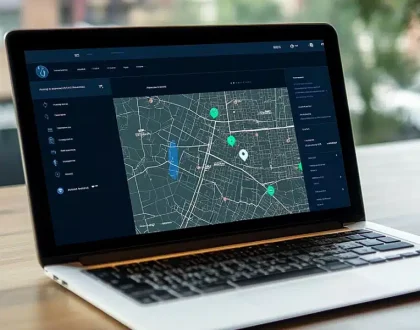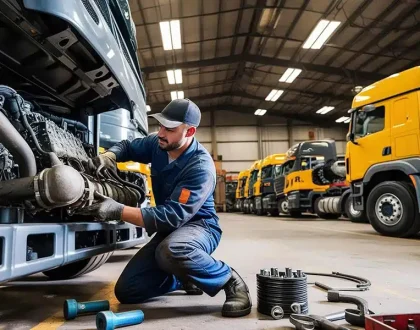
Eco Driving System: Optimizing Fleet Efficiency with En Route Technologies
Eco driving system a practice that seamlessly blends corporate efficiency with environmental protection. Implementing eco-driving habits using smart tracking and monitoring tools is essential and can be simplified for today’s fleets.
These technologies not only save gasoline but also prolong automobile life and guarantee that businesses abide by environmental regulations. Consequently, this approach allows companies to manage a more economical and environmentally friendly fleet.
Why Is Eco Driving System Important for Fleet Operations?
Eco driving system is critical for fleet operations because it increases vehicle life, reduces carbon emissions, and saves on fuel management software costs. Businesses that promote efficient driving can save money and become more ecologically responsible. Furthermore, it helps organizations satisfy regulatory obligations, thereby improving their compliance and reputation.
Reducing Fuel Costs
One of eco-driving’s primary benefits is a significant decrease in fuel costs. Adopting fuel-efficient driving techniques can drastically lower fuel consumption for businesses. When you consider a fleet’s daily petrol use, this reduction leads to substantial savings. For instance, you can greatly reduce fuel consumption by adopting simple habits like avoiding sudden brakes or maintaining a steady pace.
Promoting Environmental Responsibility
Eco driving also lowers damaging carbon emissions. Because fleets use less fuel, they actively help to create a cleaner environment. This practice ensures companies contribute to environmental projects. Moreover, it helps businesses adhere to government regulations designed to conserve the environment and lessen pollution.
Increasing Vehicle Lifespan
More cautious and efficient driving reduces vehicle wear and tear. When you pair this with regular maintenance, eco-friendly driving extends the lifespan of fleet vehicles. As a result, businesses may keep their fleets on the road longer without suffering major failures, thereby avoiding costly repairs and replacements.
Ensuring Regulatory Compliance
Using eco-driving methods makes it simple for businesses to fulfill emission and environmental criteria. This is crucial, as breaking these guidelines may have unfavorable effects. Businesses that agree to these guidelines not only stay out of trouble but also enhance their reputation by demonstrating their dedication to environmental preservation.
Saving Costs for Businesses
By using less fuel, businesses can save a lot of money and require less maintenance, thereby increasing overall efficiency. These savings lower fleet operating costs and boost profitability immediately. Therefore, implementing eco-friendly driving behaviors may significantly enhance a business’s financial success over time.
Key Elements of Eco Driving System Through Fleet Management
Real Time Vehicle Monitoring
Real-time vehicle monitoring enhances vehicle performance and fuel economy. Fleet managers can use it to monitor critical metrics like idle time, engine condition, and fuel use. By keeping a careful eye on these factors, managers can make prompt decisions to save expenses and boost productivity.
Some key aspects of real-time vehicle monitoring include:
Live fuel consumption tracking: This makes it easy to determine how much petrol is being spent.
Engine performance monitoring: This determines how well the engine is performing.
Idle time tracking: This shows how long the automobile has been sitting idle and wasting petrol.
Current management: This allows drivers to maximize their efficiency by keeping the right pace.
Route optimisation: This ensures that autos use the most efficient routes, saving time and fuel.
Driver Behavior Analysis
Driver behavior has a considerable influence on vehicle maintenance and fuel efficiency. Fleet management systems monitor driver braking, speed control, and acceleration. Improved driving habits reduce fuel consumption, vehicle wear and tear, and maintenance costs. For example, rapid acceleration wastes fuel. In contrast, smooth driving keeps the car in good shape and helps conserve fuel.
Key points of driver behavior analysis include:
Acceleration patterns: Quick acceleration wastes fuel while smooth acceleration saves it.
Braking habits: Harsh braking uses more fuel and wears down vehicle parts faster, whereas gentle braking is more efficient.
Speed consistency: Keeping a steady speed avoids fuel wastage and makes the journey smoother.
Idle time management: Reducing the time the vehicle spends idling cuts down on fuel use.
Gear shifting patterns: Using the right gears helps the engine run smoothly and saves fuel.
Preventive Maintenance Scheduling
Regular preservation is needed to maintain engines operating smoothly and prevent surprising failures. Preventive protection involves analyzing the vehicle’s situation and repairing any issues before they worsen. Over time, this method reduces protection charges and extends automobile existence. For example, routine tire strain tests may enhance the fuel economy, and prompt engine diagnostics can identify problems early.
Here are some key steps in preventive maintenance:
Regular Vehicle Checks: Inspecting vehicles often helps find issues before they lead to breakdowns.
Tire Pressure Monitoring: Keeping tires at the right pressure improves fuel efficiency and safety.
Engine Diagnostics: Running engine checks can spot minor problems before they become major repairs.
Service Scheduling: Regular service keeps vehicles in top shape, reducing the risk of unexpected issues.
Performance Optimization: Fine-tuning vehicles ensures they run efficiently, saving fuel and lowering costs.
Route Optimization
Planning optimal routes for cars is an easy method of saving time and lowering fuel usage. Finding the quickest and least crowded routes helps businesses save money on fuel, avoid traffic, and guarantee on-time delivery. In addition to increasing customer pleasure, this reduces vehicle wear and tear.
Moreover, taking eco-friendly ways improves a company’s reputation, ensures compliance with environmental regulations, and can result in cash gains and fewer fines.
Benefits of route optimization include:
Efficient route planning: Finding the best routes lowers fuel consumption and saves money.
Traffic pattern analysis: By identifying busy areas to avoid, you may save time and petrol money.
Distance optimization: This technique lowers the distance traveled, which also reduces fuel costs.
Fuel consumption monitoring: Monitoring fuel use helps find places where you can make further savings.
Time management: This makes sure cars arrive on schedule, which pleases clients and boosts overall output.
Benefits of Implementing Eco Driving System Through Fleet Management
Operational Benefits
Reduced Fuel Consumption
Eco driving system techniques help reduce fuel consumption, which benefits both the environment and your budget. By using less fuel, you can save money and also contribute to a greener planet.
Lower Maintenance Costs
Businesses may prevent costly repairs and breakdowns by practicing safer driving practices and routine maintenance. Consequently, this lowers the possibility of unexpected bills and keeps cars operating properly.
Extended Vehicle Life
Vehicle maintenance plans and eco driving system practices help drivers keep their vehicles in peak condition for longer. As a result, companies can get more usage out of their fleet, which lowers the need for replacements.
Improved Safety Records
By keeping an eye on driver behavior, companies can promote safer driving. This results in fewer collisions, which lowers insurance claims and repair expenses while also protecting drivers.
Enhanced Fleet Efficiency with eco driving system
Preventive maintenance, route optimization, and real-time tracking all work together to improve fleet operations. Therefore, overall performance improves, and companies can better reach their delivery targets.
Financial Benefits
Decreased Operational Costs
Operating costs immediately drop when you use less fuel and require less maintenance. This allows more money to be reinvested in the company.
Reduced Maintenance Expenses
Eco driving system and preventive care lower the likelihood of expensive repairs. Additionally, frequent inspections guarantee that cars are less likely to experience an unplanned breakdown.
Lower Insurance Premiums
A good track record of safety might lead to lower insurance costs. Since fewer accidents and claims occur, businesses can benefit from reduced rates, further lowering expenditures.
Better Asset Utilization
The more well-maintained and optimized the routes are, the more efficiently you can use each vehicle. By doing this, you reduce downtime and increase productivity.
Increased Profitability
Businesses may boost their profitability by lowering their fuel usage, maintenance expenses, and insurance premiums. Ultimately, when overhead costs are reduced, businesses can reinvest in their expansion.
Environmental Benefits
Reduced Carbon Emissions
Eco driving system helps to save the environment by drastically reducing carbon emissions. Essentially, using less fuel results in the emission of fewer greenhouse gasses.
Lower Environmental Impact
Fleets minimize their impact on the environment by optimizing vehicle performance and fuel consumption. Overall, this makes operations more sustainable.
Better Corporate Responsibility
Implementing eco-friendly procedures improves a business’s reputation as an accountable green enterprise. Importantly, consumers value companies that take care of the environment.
Sustainable Operations
Businesses can align with global environmental goals by using eco-driving. Subsequently, greener operations enhance a business’s reputation and long-term viability.
Green Fleet Certification
By implementing eco-friendly procedures, companies may differentiate themselves from rivals. Furthermore, they can demonstrate their dedication to sustainability by becoming eligible for green certifications.
Why Choose Enroute Technologies Fleet Management System?
State of the Art Tracking Technology
Businesses may take advantage of En Route Technologies newest tracking technology. This system ensures effective and environmentally responsible operations by giving real-time information about vehicle performance and fuel use.
Comprehensive Fleet Management Tools
Enroute Technologies provides a full suite of technologies for fleet management optimization. For instance, businesses may increase fleet efficiency in various ways, from evaluating driver behavior to devising the most efficient routes.
Expert Technical Support
Companies can depend on the committed technical support staff from Enroute Technologies to maintain their fleet management system’s functionality. This guarantee ensures the fleet will always operate at its best.
Proven Cost-Saving Solutions
Enroute Technologies helps businesses save money by scheduling preventative maintenance, optimizing fuel use, and improving route management. As a result, these solutions improve bottom lines and save on operating expenses.
Sustainable Fleet Operations
Enroute Technologies can help organizations operate their fleets more sustainably by applying eco driving system techniques. Therefore, this promotes sustained success in the market and lessens the impact on the environment.
Drive Your Fleet to Success with Enroute Technologies
Eco driving system is essential to modern fleet maintenance it’s not just a trend. With the help of Eco Driving system, businesses may improve sustainability, cut operating expenses, and use less fuel. Enroute Technologies offers the greatest fleet management solution, giving businesses access to cutting-edge tracking capabilities, driver behavior monitoring, and optimized route planning.
Your fleet can become more economical, ecologically conscious, and efficient with Enroute Technologies. Therefore, select Enroute Technologies now for unparalleled fleet performance and optimized eco driving system. Take the wise path to fleet success and sustainability.



